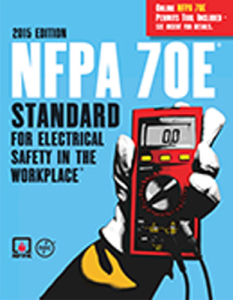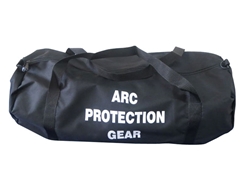
Don't let safety come as a shock! We all know electricity can cause burns, shocks and electrocution, which can be fatal. So how do we protect ourselves? Your safety is our #1 priority at All Safe Industries, therefore, we want to share some electrical safety tips with you.
Electrical Safety
- Electrical Safety & How To Prevent Injuries
- Hazard Risk Categories & Arc Ratings
- Standard NFPA 70E - 2015 Edition Changes
- Product Spotlight
1. Electrical Safety & How To Prevent Injuries
OSHA Regulations and the NFPA 70E for Electrical Safety provide work safety practices to prevent injuries against arc flashes and flash hazards. Besides making sure the equipment being used is properly maintained and working, adequate PPE with the required ratings should always be worn. This can be successfully accomplished by using the Hazard Level Risk and Arc Ratings on PPE. Remember, only your employer can tell you the required level of protection required in your job.
So, you're wearing the proper apparel and equipment, what's next? Below are a few helpful safety tips when it comes to working with electricity.
- Take into consideration the flash protection boundary, which is the distance from an exposed live part within which a person could receive a second-degree burn if an electrical arc were to occur.
- Know that a flash hazard analysis is a study investigating the potential exposure to arc-flash energy that a worker faces while performing a specific job task. This helps determine the required PPE.
- Use the 3-stage safety model: recognize, evaluate and control hazards.
- Reminder that low voltage does not mean low danger!
- Follow the Standard NFPA 70E
Arc Flash —
An explosive release of energy caused by an electrical arc. An arc flash results from either a phase to ground or a phase to phase fault caused by such occurrences as accidental contact with electrical systems, build up of conductive dust, corrosion, dropped tools, and improper work procedures. During an arc flash, the temperature can reach 35,000° Fahrenheit, and exposure to an arc flash can result in serious burn injury and death.
Flash Hazard —
A dangerous condition caused by the release of energy from an electric arc.
2. Hazard Risk Categories & Arc Ratings
The Hazard Risk Category chart is used to determine the necessary arc rating of a garment required to be worn during a job.
The ARC rating determines the protective characteristics of the fabric that is worn. The higher the ARC rating value the greater the protection by a Hazard/Risk Assessment and the resulting HRC.
HRC (Hazard/Risk Category) —
The five Hazard/Risk categories are specified by the chart listed in NFPA® 70E. The chart, based on specific job tasks, ranges from HRC 1 (which is low risk and allows for 100% treated cotton), up to HRC 4 (which is high risk and requires FR clothing with a minimum arc rating of 40). The HRC is used to determine the necessary arc rating of a garment worn during a given job task.
Arc Rating —
A value of the energy necessary to pass through any given fabric to cause with 50% probability a second or third degree burn. This value is measured in calories/cm². The necessary Arc Rating for an article of clothing is determined by a Hazard/Risk Assessment and the resulting HRC. Usually measured in terms of ATPV or EBT.
|
Hazard Risk Category
|
Clothing Descr.
|
Required Min. Arc Rating of PPE
|
|
1 HRC
|
FR shirt and FR pants or FR coveralls (1 layer)
|
4
|
|
2 HRC
|
Cotton underwear plus FR shirt and FR pants (1 or 2 layers)
|
8
|
|
3 HRC
|
Cotton underwear plus FR shirt and FR pants plus FR coveralls, or Cotton underwear plus two FR coveralls (2 or 3 layers)
|
25
|
|
4 HRC
|
Cotton underwear plus FR shirt and FR pants plus multilayer flash suit (3 or more layers)
|
40
|
3. Standard NFPA 70E - 2015 Changes
The most recent Standard NFPA 70E (2015) became effective on October 2014. It is updated every three years to ensure the best safety guidelines for electrical safety.
Below are some of the significant changes made in this edition. Get the whole
2015 Edition here.
NFPA 70E —
A work standard published by the National Fire Protection Association (NFPA®) that covers aspects of electrical safety in the workplace. It includes the recommendation that those who work with, on or around energized equipment use adequate protection, including FR clothing.
 Significant PPE Changes
Significant PPE Changes
- Terminology Change
The HRC (Hazard/Risk Category) will now be referred to as Risk Assessment
.
- Coverage Requirements Change
The word "coverall" has been added to section (d) on page 3 of the catalogue standard:
- “Shirt and coverall sleeves shall be fastened at the wrists…”
-
“…shirts, coveralls, and jackets shall be closed at the neck.”
Additionally, shirts must also now be tucked into pants to be in-line with OSHA’s recent updates to standard 29 CFR 1910.269.
- No More HRC 0
HRC 0 was eliminated from the new PPE Table, since the PPE Table only specifies work within the arc flash boundary. Having an HRC 0 would mean the worker was outside the arc flash boundary and did not need arc-rated PPE or clothing.
However, even with the HRC 0 requirement removed, there are still requirements when it comes to clothing— not wearing any melting fiber clothing when working on or operating energized electrical equipment is an example.
- FR Manufacturers
Due to these recent changes, manufacturers will need to modify labeling on arc-rated clothing to reflect the new terminology.
4. Product Spotlight
All Safe Industries has the products to keep you safe when working with electricity.
View NFPA 70E: Electrical Safety Products Now!

Read More...
NFPA
Hazard Level Risk Ratings Explained
This entry was posted in no categories.